Client Matter Codes and Forced Authentication Codes
Forced Authentication Codes (FACs) and Client Matter Codes (CMCs) allow you to manage call access and accounting. CMCs are often referred to as account codes and assist with call accounting and billing for billable clients. FACs regulates the types of calls that certain users can place.
The CMC feature benefits law offices, accounting firms, consulting firms, and other businesses or organizations that need to track the length of the call for each client. To use the CMC feature, users must enter a client matter code to reach certain dialed numbers.
You can use FAC for colleges, universities, or any business or organization when limiting access to specific classes of calls proves beneficial. Likewise, when you assign unique authorization codes, you can determine which users placed calls.
FAC Concepts
For each user, you specify an authorization code, and then you enable FAC for relevant route patterns by checking the appropriate check box and specifying the minimum authorization level for calls through that route pattern.
When you enable FAC through route patterns in Cisco CallManager Administration, users must enter an authorization code to reach the intended recipient of the call. When a user dials a number that is routed through a FAC-enabled route pattern, the system plays a tone that prompts for the authorization code. Figure 17-11 illustrates the FAC process, which follows these steps:
|
Step 1. |
A user dials a number that goes to a FAC-enabled route pattern. |
|
Step 2. |
Cisco CallManager tells the phone to play the tone. |
|
Step 3. |
The user enters the authorization code, followed by the # key. |
Note
The pound sign (#) at the end of the client matter code cancels the interdigit timeout. If users do not append the # to the authorization code or client matter code, the system waits for the T302 timer to extend the call (System > Service Parameters for the Cisco CallManager service). The default for the T302 timer is 15 seconds.
|
Step 4. |
The call is extended to the exiting gateway. |
|
Step 5. |
CallManager generates a Call Detail Record (CDR) flagged with the FAC number. |
Figure 17-11. FAC Process
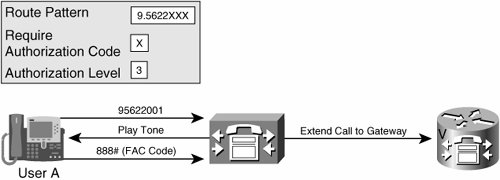
In Cisco CallManager Administration, you can configure various levels of authorization. Users are given codes that assign them a certain authorization level. Route patterns are then assigned authorization levels. If the user authorization code does not meet the level of authorization that is specified to route the dialed number, the user receives a reorder tone. If the authorization is accepted, the call is placed. The name of the authorization writes to Call Detail Records (CDRs), so that you can organize the information by using CDR Analysis and Reporting (CAR), which generates reports for accounting and billing.
To implement FAC, you must devise a list of authorization levels and corresponding descriptions to define the levels. You must specify authorization levels in the range from 0 to 255. Cisco allows authorization levels to be arbitrary, so that you define what the numbers mean for your organization. For example, you could configure authorization levels as follows:
- Configure an authorization level of 10 for interstate long-distance calls in North America.
- Because intrastate calls often cost more than interstate calls, configure an authorization level of 20 for intrastate long-distance calls in North America.
- Configure an authorization level of 30 for international calls.
CMC Concepts
You apply CMC through route patterns, and you can configure multiple client matter codes. When a user dials a number that is routed through a CMC-enabled route pattern, a tone prompts the user for the client matter code. When the user enters a valid code, the call is placed; if the user enters an invalid code, a reorder tone is played. CMC is written to the CDR, so you can collect the information by using CAR, which generates reports for client accounting and billing.
Tip
The FAC and CMC features are very similar and often confused. Cisco created the FAC primarily to prevent toll fraud and to limit and track the users able to make calls by authorization levels. CMC is a nearly identical feature allowing organizations to track calls based on the CMC code dialed rather than authorization level.
Figure 17-12 shows a basic CMC call where the route pattern 8.@ is configured to require the user to enter a client matter code:
|
Step 1. |
When the user dials 8-214-555-0134, the dialed string matches the 8.@ route pattern. |
|
Step 2. |
Cisco CallManager plays a "zip-zip" tone to prompt the user to enter the client matter code associated with the dialed string, in this example, 1234. |
|
Step 3. |
If the user enters 1234 followed by the # key, the call is immediately extended to the voice gateway. If the user does not enter a code or enters the wrong code, the user hears a reorder tone, and the call is not extended. |
|
Step 4. |
Because the user entered a valid code, Cisco CallManager extends the call to the voice gateway for call completion. |
|
Step 5. |
Cisco CallManager generates a CDR with the associated client matter code for client-tracking and reporting purposes. |
Figure 17-12. CMC Process
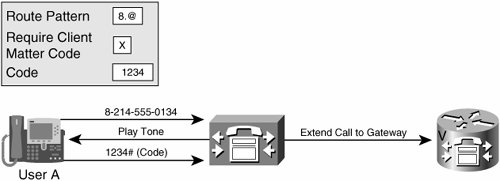
CMC and FAC can be implemented together for a given route pattern. For example, you can allow only certain users to have authorization to place certain long-distance calls, and then require the user to enter a CMC for that call. The tones for CMC and FAC sound the same to the user, so the feature tells the user to enter the authorization code after the first tone and enter the account code after the second tone.
FAC and CMC Configuration
To implement CMC or FAC, you can perform the following steps:
|
Step 1. |
If using CMCs, create a document with a list of CMCs and associated client names that you want to track. If using FACs, create a document listing the authorization levels you want to create and the authorization levels required for restricted route patterns. |
|
Step 2. |
Insert the CMC or FAC codes by using Cisco CallManager Administration (choose Feature > Client Matter Code or Feature > Forced Authorization Code). |
|
Step 3. |
To enable FAC or CMC, update route patterns by selecting Require Client Matter Code or Require Forced Authorization Code and entering the level of FAC required. |
|
Step 4. |
Update dial plan documents as necessary. |
|
Step 5. |
Provide information to users and explain how the feature works. |
Creating CMC Codes
Complete the following steps to add CMCs in Cisco CallManager Administration:
|
Step 1. |
In Cisco CallManager Administration, choose Feature > Client Matter Code. |
|
Step 2. |
In the upper-right corner of the window, click the Add a New Client Matter Code link. |
|
Step 3. |
In the Client Matter Code field, enter a unique code of no more than 16 digits that users will enter when placing a call, as shown in Figure 17-13. The client matter code displays in the CDRs for calls that use this code. Figure 17-13. CMC Configuration 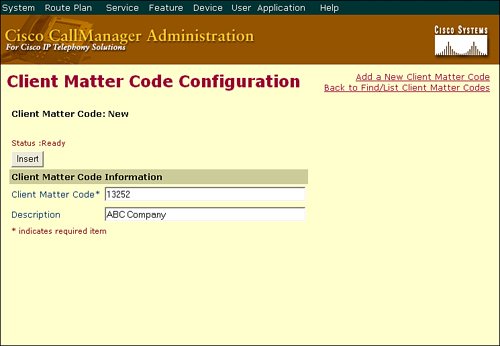
|
|
Step 4. |
In the Description field, enter a name of no more than 50 characters. This optional field associates a client code with a client. |
|
Step 5. |
Click Insert. |
Creating FAC Codes
Complete the following steps to add FACs in Cisco CallManager Administration:
|
Step 1. |
In Cisco CallManager Administration, choose Feature > Forced Authorization Code. |
|
Step 2. |
In the upper-right corner of the window, click the Add a New Forced Authorization Code link. |
|
Step 3. |
In the Authorization Code Name field, enter a logical name representing the authorization, as shown in Figure 17-14. Figure 17-14. FAC Configuration 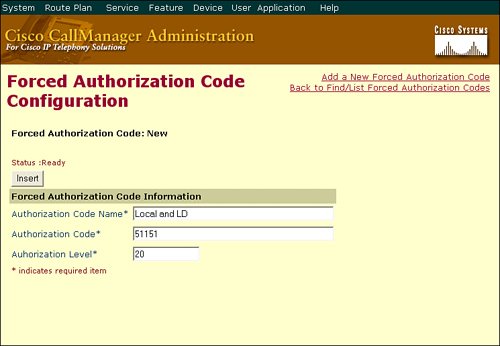
|
|
Step 4. |
In the Authorization Code field, enter the code users will dial to obtain this level of authorization. |
|
Step 5. |
In the Authorization Level field, enter the level of authorization the user obtains if they enter the authorization code. |
|
Step 6. |
Click Insert. |
Enabling Route Patterns for FAC and CMC
Complete the following steps to enable route patterns for FAC and CMC:
|
Step 1. |
In Cisco CallManager Administration, choose Route Plan > Route/Hunt > Route Pattern. |
|
Step 2. |
Open the properties window for the route pattern you want to modify. |
|
Step 3. |
If you are configuring the route pattern for CMC, check the Require Client Matter Code check box, as shown in Figure 17-15. Figure 17-15. Route Pattern Configuration 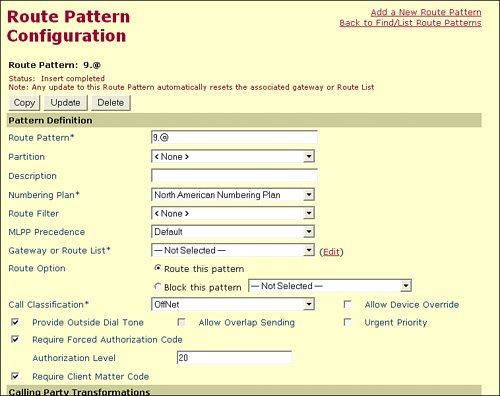
|
|
Step 4. |
If you are configuring the route pattern for FAC, check the Require Forced Authorization Code check box and enter the level of authorization required to access this route pattern. |
|
Step 5. |
Click Update. |
Part I: Cisco CallManager Fundamentals
Introduction to Cisco Unified Communications and Cisco Unified CallManager
Cisco Unified CallManager Clustering and Deployment Options
- Cisco Unified CallManager Clustering and Deployment Options
- The Two Sides of the Cisco Unified CallManager Cluster
- Cluster Redundancy Designs
- Call-Processing Deployment Models
- Summary
- Review Questions
Cisco Unified CallManager Installation and Upgrades
- Cisco Unified CallManager Installation and Upgrades
- Cisco Unified CallManager 4.x Clean Installation Process
- Upgrading Prior Cisco Unified CallManager Versions
- Summary
- Review Questions
Part II: IPT Devices and Users
Cisco IP Phones and Other User Devices
Configuring Cisco Unified CallManager to Support IP Phones
- Configuring Cisco Unified CallManager to Support IP Phones
- Configuring Intracluster IP Phone Communication
- IP Phone Configuration
- Case Study: Device Pool Design
- Summary
- Review Questions
Cisco IP Telephony Users
- Cisco IP Telephony Users
- Cisco CallManager User Database
- Cisco CallManager User Configuration
- User Logon and Device Configuration
- Summary
- Review Questions
Cisco Bulk Administration Tool
- Cisco Bulk Administration Tool
- The Cisco Bulk Administration Tool
- Using the Tool for Auto-Registered Phone Support
- Summary
- Review Questions
Part III: IPT Network Integration and Route Plan
Cisco Catalyst Switches
- Cisco Catalyst Switches
- Catalyst Switch Role in IP Telephony
- Powering the Cisco IP Phone
- Data and Voice VLANs
- Configuring Class of Service
- Summary
- Review Questions
Configuring Cisco Gateways and Trunks
- Configuring Cisco Gateways and Trunks
- Cisco Gateway Concepts
- Configuring Access Gateways
- Cisco Trunk Concepts
- Configuring Intercluster Trunks
- SIP and Cisco CallManager
- Summary
- Review Questions
Cisco Unified CallManager Route Plan Basics
- Cisco Unified CallManager Route Plan Basics
- External Call Routing
- Route Plan Configuration Process
- Summary
- Review Questions
Cisco Unified CallManager Advanced Route Plans
- Cisco Unified CallManager Advanced Route Plans
- Route Filters
- Discard Digit Instructions
- Transformation Masks
- Translation Patterns
- Route Plan Report
- Summary
- Review Questions
Configuring Hunt Groups and Call Coverage
- Configuring Hunt Groups and Call Coverage
- Call Distribution Components
- Configuring Line Groups, Hunt Lists, and Hunt Pilots
- Summary
- Review Questions
Implementing Telephony Call Restrictions and Control
- Implementing Telephony Call Restrictions and Control
- Class of Service Overview
- Partitions and Calling Search Spaces Overview
- Time-of-Day Routing Overview
- Configuring Time-of-Day Routing
- Time-of-Day Routing Usage Scenario
- Summary
- Review Questions
Implementing Multiple-Site Deployments
- Implementing Multiple-Site Deployments
- Call Admission Control
- Survivable Remote Site Telephony
- Summary
- Review Questions
Part IV: VoIP Features
Media Resources
- Media Resources
- Introduction to Media Resources
- Conference Bridge Resources
- Media Termination Point Resources
- Annunciator Resources
- Transcoder Resources
- Music on Hold Resources
- Media Resource Management
- Summary
- Review Questions
Configuring User Features, Part 1
- Configuring User Features, Part 1
- Basic IP Phone Features
- Softkey Templates
- Enhanced IP Phone Features
- Barge and Privacy
- IP Phone Services
- Summary
- Review Questions
Configuring User Features, Part 2
- Configuring User Features, Part 2
- Cisco CallManager Extension Mobility
- Client Matter Codes and Forced Authentication Codes
- Call Display Restrictions
- Malicious Call Identification
- Multilevel Precedence and Preemption
- Summary
- Review Questions
Configuring Cisco Unified CallManager Attendant Console
- Configuring Cisco Unified CallManager Attendant Console
- Introduction to Cisco CallManager Attendant Console
- Call Routing and Call Queuing
- Server and Administration Configuration
- Cisco Attendant Console Features
- Summary
- Review Questions
Configuring Cisco IP Manager Assistant
- Configuring Cisco IP Manager Assistant
- Cisco IP Manager Assistant Overview
- Cisco IP Manager Assistant Architecture
- Configuring Cisco IPMA for Shared-Line Support
- Summary
- Review Questions
Part V: IPT Security
Securing the Windows Operating System
- Securing the Windows Operating System
- Threats Targeting the Operating System
- Security and Hot Fix Policy
- Operating System Hardening
- Antivirus Protection
- Cisco Security Agent
- Administrator Password Policy
- Common Windows Exploits
- Security Taboos
- Summary
- Review Questions
Securing Cisco Unified CallManager Administration
- Securing Cisco Unified CallManager Administration
- Threats Targeting Remote Administration
- Securing CallManager Communications Using HTTPS
- Multilevel Administration
- Summary
- Review Questions
Preventing Toll Fraud
- Preventing Toll Fraud
- Toll Fraud Exploits
- Preventing Call Forward and Voice-Mail Toll Fraud Using Calling Search Spaces
- Blocking Commonly Exploited Area Codes
- Using Time-of-Day Routing
- Using FAC and CMC
- Restricting External Transfers
- Dropping Conference Calls
- Summary
- Review Questions
Hardening the IP Phone
Understanding Cryptographic Fundamentals
- Understanding Cryptographic Fundamentals
- What Is Cryptography?
- Symmetric Encryption
- Asymmetric Encryption
- Hash Functions
- Digital Signatures
- Summary
- Review Questions
Understanding the Public Key Infrastructure
- Understanding the Public Key Infrastructure
- The Need for a PKI
- PKI as a Trusted Third-Party Protocol
- PKI Entities
- PKI Enrollment
- PKI Revocation and Key Storage
- PKI Example
- Summary
- Review Questions
Understanding Cisco IP Telephony Authentication and Encryption Fundamentals
- Understanding Cisco IP Telephony Authentication and Encryption Fundamentals
- Threats Targeting the IP Telephony System
- How CallManager Protects Against Threats
- PKI Topologies in Cisco IP Telephony
- PKI Enrollment in Cisco IP Telephony
- Keys and Certificate Storage in Cisco IP Telephony
- Authentication and Integrity
- Encryption
- Summary
- Review Questions
Configuring Cisco IP Telephony Authentication and Encryption
- Configuring Cisco IP Telephony Authentication and Encryption
- Authentication and Encryption Configuration Overview
- Enabling Services Required for Security
- Using the CTL Client
- Working with Locally Significant Certificates
- Configuring the Device Security Mode
- Negotiating Device Security Mode
- Generating a CAPF Report
- Summary
- Review Questions
Part VI: IP Video
Introducing IP Video Telephony
- Introducing IP Video Telephony
- IP Video Telephony Solution Components
- Video Call Concepts
- Video Protocols Supported in Cisco CallManager
- Bandwidth Management
- Call Admission Control Within a Cluster
- Call Admission Control Between Clusters
- Summary
- Review Questions
Configuring Cisco VT Advantage
- Configuring Cisco VT Advantage
- Cisco VT Advantage Overview
- How Calls Work with Cisco VT Advantage
- Configuring Cisco CallManager for Video
- Configuring Cisco IP Phones for Cisco VT Advantage
- Installing Cisco VT Advantage on a Client
- Summary
- Review Questions
Part VII: IPT Management
Introducing Database Tools and Cisco Unified CallManager Serviceability
- Introducing Database Tools and Cisco Unified CallManager Serviceability
- Database Management Tools
- Cisco CallManager Serviceability Overview
- Tools Overview
- Summary
- Review Questions
Monitoring Performance
- Monitoring Performance
- Performance Counters
- Microsoft Event Viewer
- Microsoft Performance Monitor
- Real-Time Monitoring Tool Overview
- Summary
- Review Questions
Configuring Alarms and Traces
- Configuring Alarms and Traces
- Alarm Overview
- Alarm Configuration
- Trace Configuration
- Trace Analysis
- Trace Collection
- Bulk Trace Analysis
- Additional Trace Tools
- Summary
- Review Questions
Configuring CAR
- Configuring CAR
- CAR Overview
- CAR Configuration
- Report Scheduling
- System Database Configuration
- User Report Configuration
- Summary
- Review Questions
Using Additional Management and Monitoring Tools
- Using Additional Management and Monitoring Tools
- Remote Management Tools
- Dependency Records
- Password Changer Tool
- Cisco Dialed Number Analyzer
- Quality Report Tool
- Summary
- Review Questions
Part VIII: Appendix
Appendix A. Answers to Review Questions
Index
EAN: 2147483647
Pages: 329
